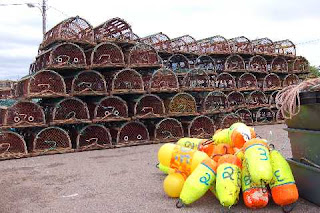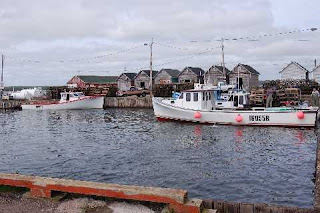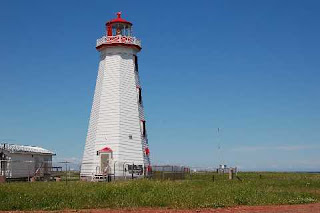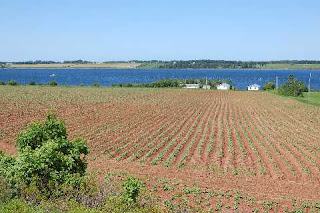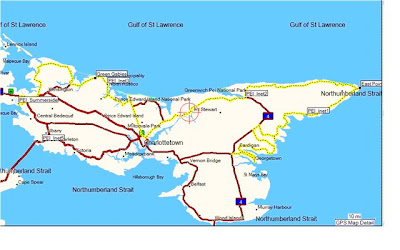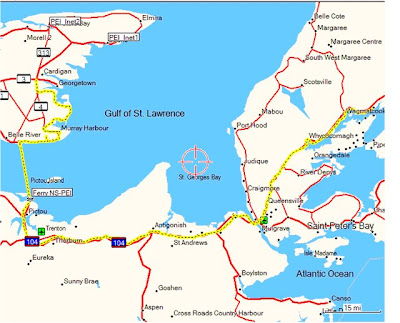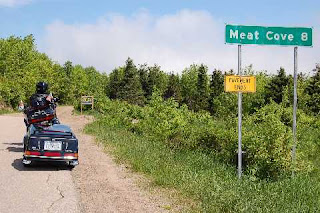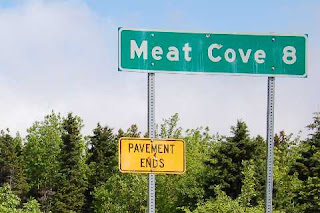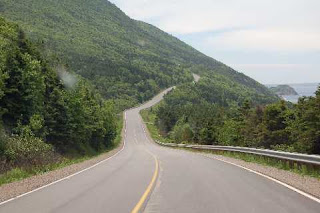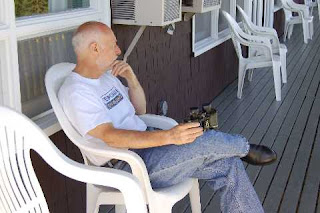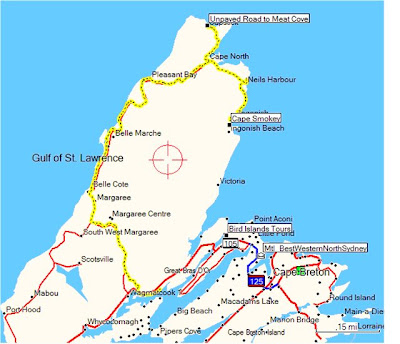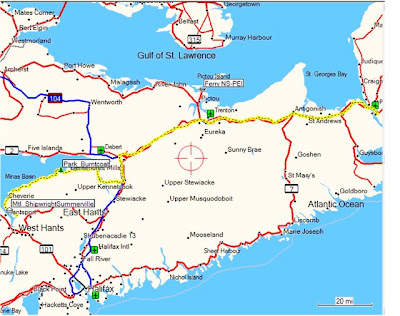Nova Scotia 2007
Day 18: Tuesday July 3
Copyright(c) 2007, Jim Beachy
We’ve slept in and poked around as long as we can, but even so we’re sitting in the breakfast lounge of the Comfort Inn by 8:30, and news is on the television. It occurs to me that we haven’t watched a minute of television on our trip except the occasional Canadian Weather Network when we could get it. This morning, there are reports of arson, murder, and mayhem, and I’m feeling a lot like Paul Simon: “I can gather all the news I need in the weather report” (The Only Living Boy in New York). Life seemed simpler on the Cabot Trail.
This morning, there’s a hint of warmth in the air, contrasted to the previous several weeks when each morning bore the hint of a deep chill. By 9:30 AM, I’m doing one last T-CLOCK (Tires, Controls, Lights, Oil, Chassis, and Kickstand) inspection, which I do every morning. We get on the bike and Kitty softly offers one last “And there we go.” And just like that, we are back on I-78 headed westward at the sedate speed limit of 55 mph for that section of under-construction highway. Pennsylvania police presence is everywhere in full force today so everyone is running the speed limit.
Even with the temperature of 68 F, once out on the Interstate I close all the vents on my Wing to take off the chill. As we ride 75 miles or so to Harrisburg, Pennsylvania to catch I-81 southward toward home, we are both in a reflective mood and say little. A few thoughts bubble up as I think back over our adventure.
A few thoughts about apparel. We always ride in leather jackets and gloves unless the weather is just too hot, and this trip was perfect, with temperatures ranging from low 50’s F to very low 70’s F, typically in the 60’s F during the Canadian part of the trip. Perfect jacket weather. We have jacket liners and other “layering” clothing that we can put on or take off as the temperature dictates. At no time did we struggle to stay warm or struggle to stay cool. We both have waterproof Cruiserworks boots (http://www.cruiserworks.com/) that we wear on and off the bike (except for sneakers that we wear for our power walks), and those performed perfectly, even in the downpour out of Baddeck. We have one-piece Motoport Samoa® rain suits (http://www.motoport.com) that have served us well over the years. They have a slippery silky interior that feels good and facilitates getting into or out of them. Were I buying rain suits today I might consider two-piece suits, but these suits have kept us absolutely dry in the worst rain conditions. The SealSkinz rain gloves (http://www.sealskinz.com), constructed rather like a rubber wet suit with little “gripper dots” on the palm and finger surfaces, offer the best dexterity and control-surface feeling of any rain glove solution I’ve tried. They worked extremely well except that for extended riding in temperatures below 60 F they’re a bit chilly as the outer layer collects water which then evaporates, even though they are bone-dry on the inside (http://www.danalco.com/). Our Escapade trailer has a garment bag attached to the lid, and every year we debate whether to put “dress up clothes” in it. This year, I included an extra pair of jeans and a shirt; Kitty added a nice shirt and a spiffy denim jacket. When Kitty is fully reconstituted after a day under her helmet, dressed in her nice jeans and shirt with that spiffy denim jacket and her motorcycle boots, let me tell you, this is one stylin’ woman! And if we can’t go somewhere with her looking like that, we ain’t goin’! That’s as dressed-up as it gets on our trips.
A few thoughts about equipment. We have new Shoei RF1000 helmets (http://www.shoei-helmets.com/) with J&M headsets (http://www.jmcorp.com/), which we find much quieter than our previous RF700 model helmets. The passenger helmet’s microphone, which in many helmets is prone to pick up objectionable wind noise, picks up virtually no wind noise in this helmet. Kitty in particular likes the new helmet because it’s more balanced with less weight in back, and she doesn’t feel it pulling her head backward after a long day in the saddle. The trade-off is a little more wind around the neck because of the way the helmet is shaped, despite a miniature spoiler at the neck base and near the top of the helmet. Regarding the bike itself, our Honda Gold Wing performed flawlessly. It did exactly what I asked and what I expected, all the time, every time. The low-beam headlight was presumably a casualty of the miles of rough road we traversed. Normally I carry a spare with me but I’d given it to a WOTI person, I think, probably at last year’s Alamo Run in San Antonio, and forgotten to replace it. I’ll definitely put that on the list for the next trip. The Escapade trailer (http://www.californiasidecar.com) is a joy. It doesn’t seem to care how it’s loaded or whether the load is well balanced, although I always try to be careful and maintain a proper tongue weight. On the road, there’s no evidence that it’s behind me except for the expected decrease in fuel mileage and the weight I can feel while traveling up or down steep hills. Sometimes I’m a little embarrassed when I realize that we can hardly carry all our stuff in one trip to the hotel room, but it certainly makes motorcycle traveling a lot easier. The trailer and bike are long, longer than a minivan, so this has to be kept in mind when looking for places to turn around or positioning in a parking lot. I inspect the bike and trailer every morning, and check the trailer wheels at almost every stop by putting my hands on the tires to feel warmth and inflation, and also check the heat of the wheel bearings simply by touching the hub of the wheel.
As we catch US 15 southward near Harrisburg, toward Maryland and home to Virginia, Kitty comments, “The fields look dry compared to the fields in Prince Edward Island.” Indeed the fields and lawns in that province were intense, lush green, green, green, everywhere, except for the red-earth potato fields.
A few thoughts about brotherhood. Or sisterhood. When two new mothers compare their experiences, there's a bond that can't really be shared except between those who've had similar experiences. When I walk up to another biker in a parking lot and we’re both far from home, there’s an immediate connection, a shared experience, a knowledge that we’ve both braved the elements, navigated all the turns, and felt the same exhilaration a motorcycle offers. Often we have shared some of the same rides: Cape Smokey on the Cabot Trail; the Million Dollar Highway in Colorado; the Going to the Sun Highway in Glacier National Park; Coastal Route 1 in California; Nevada’s Loneliest Highway in America; the winds of the Laguna Mountains out of San Diego. It’s a brotherhood. I think that same brotherhood must exist among lobster-fishermen. I failed to ask any of the ones we talked to about theft, but Peter Shearer says they look out for each other, even to the extent of fishing each other’s pots when there’s a disability, keeping the catches separate and turning over the proceeds to the proper owner. It’s a brotherhood. In a measure, it’s not unlike the brotherhood of a shared faith. I became acutely aware of this phenomenon in the year 2000 while Driving Miss Kitty, when we rode US Rt. 50 from coast to coast. Out there in Nevada, on the Loneliest Highway, a gas station in a tiny town might stay open 24 x 7 even though they may get only one customer per week in off-hours, just because someone might need their services. I sensed the same thing in Nova Scotia’s remote villages where, as in Nevada, a survivalist instinct pervades the culture. It’s what made Dave siphon out all his gasoline for us and then refuse to take a dime in payment. It’s the Maritime Way. It’s something to cherish, something that still exists in the rural communities of Pennsylvania where I grew up, something I long for and wish our east-coast culture could recapture.
We enter Maryland on US 15 and roll through the gentle valleys and farmlands. I ask Kitty if she wants to ride a more roundabout route home. “No,” she says, “Now that we’re going home, I just want to go home.” So we keep what we’ve got and continue on US 15 toward Frederick, Maryland.
A few thoughts about metric conversions. I got several helpful e-mails with metric conversion tricks. Well, I know how to convert the measurements, but I wanted to “understand” the metric values without converting, so that I could “feel” 12 degrees centigrade, or inherently understand “40 km”, or know without checking when I’m running “80 kph”. I got some of it, in particular the speed thing, but it would take a good bit of immersion to make the transition. I never got close to “understanding” liters-to-gallons even though I know the conversion factor. I just know that it was a shock to see $22.95 on the pump to fill up my Wing with Regular grade of gasoline, which in Canada translated to as much as $4.46 per US gallon.
A few thoughts about our traveling preferences. Sitting in a restaurant in Riverview, New Brunswick, Peter Shearer articulated well what has been our credo without actually knowing it: “Ride to the end of the road to see the last lighthouse.” This describes us so very well. Most would probably look for more interesting tourist things to do, but Kitty and I are content just to find that last lighthouse on the road less traveled. This has led us to a lot of pretty rough roads both in Nova Scotia and Prince Edward Island, and to do this you have to be prepared to ride whatever speed the road surface will bear. Not all those roads were as scenic as we would have hoped, but the rewards were special nevertheless.
A few thoughts about GPS. I have a Garmin StreetPilot 2720 that’s wired into our headsets. It comes pre-loaded with detailed Navteq® maps and millions of waypoints for the USA, Canada, and Puerto Rico, along with a base map of Mexico. I use it to find fuel, lodging, and places to eat. In Canada, I found I had to resort to some little-used ancient techniques like looking in guidebooks, because the nearest GPS waypoints listed were often hundreds of kilometers away or even in the US. The road information, however, was generally top-notch in Canada as well as the US. Given our travel preferences, the GPS is an invaluable traveling companion that I would not want to do without. Time and again, I was able to choose the road that led to “the last lighthouse” because I could see it on the GPS and could figure out how to get back out. When used as a routing tool, I have to confess I frequently don’t inspect the route; I just go where Jill or Emily tells me. The voice guidance system is phenomenal, as it announces enough information to know which lane I should be in and when to expect the next turn. It has tons of nifty statistics and mileage logs, and every couple days I download the tracks to my laptop so we can see exactly where we’ve been. Kitty always seems to find the vertical track profile particularly fascinating.
A few thoughts about guidebooks. Since the out-of-way places you may visit in Nova Scotia and Prince Edward Island may not have waypoints such as lodging or attractions in a GPS map, I found myself reverting to guidebooks quite a bit. I recommend two highly useful guidebooks, both available free at http://www.novascotia.com/ride/ or just http://www.novascotia.com, along with numerous other useful resources. One is the doers’ & dreamers’ guide, which lists virtually every lodging accommodation in Nova Scotia and has very nice lists of events and their dates throughout the province, as well as suggested touring routes complete with place-by-place information as you travel the routes. This is the one book I would not travel to Nova Scotia without. The other is Motorcycle Tour Guide Nova Scotia, which is specific in listing biker-friendly places and events as well as dealers. If you want to plan your trip on the Internet, an excellent resource is http://www.destination-ns.com. Prince Edward Island has some similar books and resources. Check out http://www.motorcyclepei.com for some tours, downloadable resources, and to order your motorcycling guide. The PEI tourism website is http://www.gov.pe.ca/visitorsguide. We picked up these books and brochures, including a motorcycle-specific brochure, at the first PEI Information Center we came to. And when all else fails, type virtually anything remotely resembling what you want into Google and you’ll get more links than you can follow!
We enter Virginia when we cross the bridge over the Potomac River at Point of Rocks, Maryland, and head toward Leesburg, Virginia. I tell Kitty I will honor the two-lane nature of this trip and finish out the ride on US 15, not on the four-lane road past Dulles Airport that the GPS has suggested.
A few thoughts about technology and Internet access. Nova Scotia and Prince Edward Island have both made a great effort to make Internet technology available to the public. Throughout both provinces, there are public Internet access points, typically at libraries and visitor centers. When we entered Prince Edward Island, I got a printed list of all these access points and loaded them as waypoints into my GPS so I could locate the nearest Internet access point wherever we were in the province. Some of the stations have WiFi, others just have computers available for public use. I posted quite a number of my blogs using those terminals, as the technology has not spread to many of the lodging establishments. However, the extent of deployment to even those places surprised me.
We catch US 50 at Gilbert’s Corner, and in 9 miles make the last right turn toward home on Pleasant Valley Drive. Soon, American Jill Version 1.80 makes one last announcement: “Turn left on Blueridge View Drive, then arrive at home on right.” It startles me. I haven’t actually thought about arriving at home. But sure enough, here we are, shortly after 1:15 PM, having ridden almost exactly 200 miles today. We’ve ridden 4,183 miles according to the GPS, exactly 4,200 by the odometer. The GPS is always more accurate.
We have left behind the red earth and steep-roofed, immaculate houses of Prince Edward Island; the bald eagles, spectacular riding, and surf-beaten cliffs of the Cabot Trail; the bright blue, red, yellow, and pink Nova Scotia homes with their wash lines on pulleys, elevated for the deep-snow winters; the picturesque working harbors and fleets of lobster boats; the succulent hot steaming lobsters of Cook’s Lobster House. Now we have our memories, along with these feeble stories and several hundred digital photographs that I’ll edit later. Yes, we have left that behind, but what we have gained is a pebble, smaller than a golf ball, carefully placed in the middle of our kitchen table. It’s a priceless little welcome-home present from our granddaughter Danica, who always brings in a pebble from our landscaped walkway when she visits.
Kitty is the best travel companion I could ask for. I am so blessed to have a partner who loves the same things I do, who enjoys traveling by motorcycle, seeing new places, experiencing new cultures and geography. She is just the best! And in return, I try to script our trips to avoid all snakes. In this, at least, I have been successful. I probably get a “C” grade on the other two Rules: No Cities, No Traffic. When we left Dad’s a couple weeks ago, I asked if she wanted music. “I’m not ready for that yet,” was her response. She never countermanded that, and we’ve done this entire trip without turning on the radio or other programs even once, except for about 10 minutes when we turned on an AM station with information about Acadia National Park.
So we’ve had another great adventure, have seen some new sights and made some new friends, but best of all we rediscovered the treasure that found voice in the dining room of the tiny Shipwright Inn in Summerville, Nova Scotia, a place so far off the beaten path that people 100 km away have never heard of the village: “Together is the best place to be.” We did this together, and it’s been a fantastic ride. And now we’re home, and we’re still together.
Wherever you are, together is the best place to be.



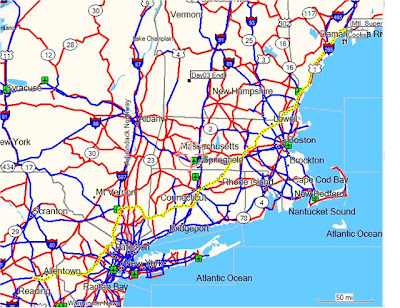
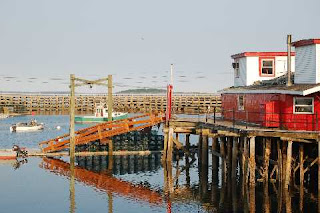
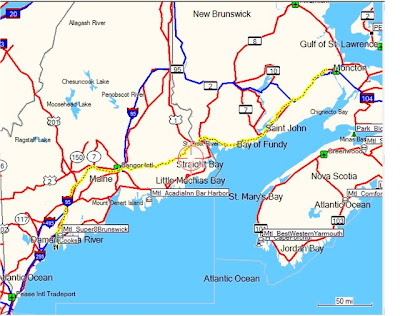
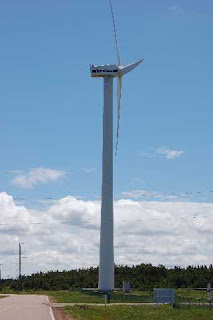
 documents our visit to both the East Point and the North Cape lighthouses. I check my GPS to see if this is the farthest north we have ever been. It is not. The north end of Cape Breton Island, the point where the road from Capstick to Meat Cove turns to dirt, beats us by about 3 degrees of latitude.
documents our visit to both the East Point and the North Cape lighthouses. I check my GPS to see if this is the farthest north we have ever been. It is not. The north end of Cape Breton Island, the point where the road from Capstick to Meat Cove turns to dirt, beats us by about 3 degrees of latitude. 

